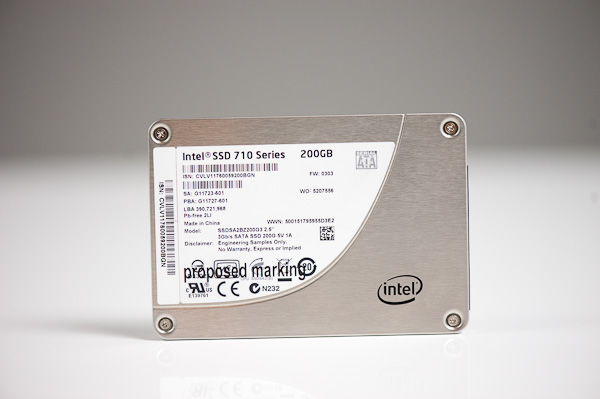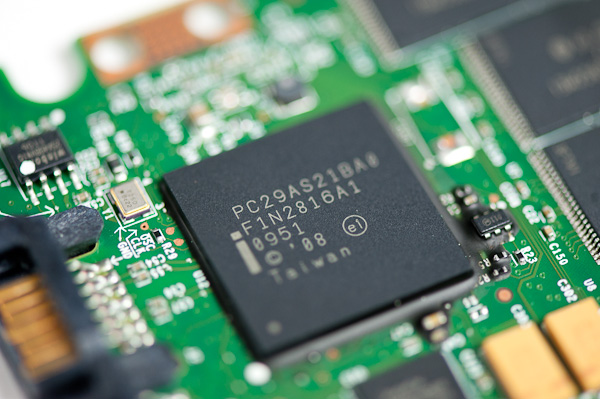The Intel SSD 710 (200GB) Review
by Anand Lal Shimpi on September 30, 2011 8:53 PM EST- Posted in
- Storage
- SSDs
- Intel
- Intel SSD 710
When Intel entered the SSD market one of its declared goals was to bring the technology into the mainstream. The goal was so important to Intel that its consumer drive was branded X25-M, with the M standing for mainstream. Intel's desire for SSD ubiquity wasn't entirely altruistic however. Mechanical storage acted as a potential gate to increasing CPU performance. Eventually, without significant improvements in IO performance, CPU improvements would be less visible to most users. SSDs would help alleviate this bottleneck.
It wouldn't be untrue to say that Intel accomplished its mission. The client SSD market was in a state of disarray before Intel arrived on the scene. Although we still have problems today, there are a number of affordable options for end users and lots of competition. Samsung, Marvell, Indilinx, JMicron and even SanDisk are now vying for control of the market.
With healthy competition, significant performance improvements and (hopefully) improved reliability in the consumer SSD space, Intel will actually begin defocusing itself from this market over the coming years. Intel needs to keep margins as high as possible to appease shareholders, and the consumer SSD business is in a race to the bottom. Dollars per GB are all that matter here once you deliver a certain level of performance and reliability.
Intel won't abandon the consumer SSD market completely, it will still compete in the high end space but there's a good reason that the mainstream moniker has been dropped from Intel's product names. Intel will shift more of its attention to the enterprise space, bringing that technology to the high end desktop/workstation users where it can (e.g. Cherryville will be focused on both enterprise and enthusiast desktop users). But as you have already seen, I wouldn't expect Intel to actively compete in driving mainstream SSD pricing down further. That market now belongs to the players I mentioned above.
What better way to kick off the shift in focus than with a new enterprise drive: Intel's SSD 710, the long awaited successor to the X25-E. Unlike previous Intel SSDs however the 710 isn't aimed at significantly improving performance. Instead the 710 attempts to offer larger capacities than the X25-E, at similar endurance and performance levels. That's right, the 710 shouldn't outperform the X25-E, it'll just be cheaper.
At first glance that's not a very impressive claim. The X25-E came out in 2008 (available in early 2009) and hasn't been updated since. Delivering performance similar to that of a three-year-old SSD doesn't sound all that exciting. If huge performance gains are what you're after, the SSD 710 isn't for you.
The 710 is built off the same architecture as the Intel SSD 320. It uses the same controller but with a newer firmware revision. The firmware is obviously also tuned for enterprise workloads.
| Enterprise SSD Comparison | |||||
| Intel SSD 710 | Intel X25-E | Intel SSD 320 | |||
| Capacities | 100 / 200 / 300GB | 32 / 64GB | 80 / 120 / 160 / 300 / 600GB | ||
| NAND | 25nm HET MLC | 50nm SLC | 25nm MLC | ||
| Max Sequential Performance (Reads/Writes) | 270 / 210 MBps | 250 / 170 MBps | 270 / 220 MBps | ||
| Max Random Performance (Reads/Writes) | 38.5K / 2.7K IOPS | 35K / 3.3K IOPS | 39.5K / 600 IOPS | ||
| Endurance (Max Data Written) | 500TB - 1.5PB | 1 - 2PB | 5 - 60TB | ||
| Encryption | AES-128 | - | AES-128 | ||
| Power Safe Write Cache | Y | N | Y | ||
| Temp Sensor | Y | N | N | ||
Since it uses the same controller as the 320, you get the same benefits. There's still no 6Gbps support, but you do get full disk encryption (enabled via ATA password). Intel also outfits the 710 with capacitors to ensure any data stored in the controller's caches can be committed to NAND in the event of a power failure. The 710 also includes surplus NAND arrays (and data redundancy). In the event of a full NAND die failure, you shouldn't see any data loss.
What Intel promises with the 710 is reliability and a clear upgrade path from the X25-E. The idea here is most enterprise workloads exist on mechanical drives today. Moving to a small array of SSDs quickly alleviates any IO bottlenecks, then the only issues that remain are cost, capacity and reliability. It's the three of these areas that the SSD 710 looks to address.
Don't get too excited about the cost angle though. While the Intel SSD 710 drives cost-per-GB down much lower than the old X25-E, it is still an enterprise drive so expect to pay more than what you'd find as a consumer.
The pricing breakdown is below:
| Intel SSD 710 Pricing Comparison | ||||||
| X25-E 64GB | 100GB | 200GB | 300GB | |||
| Price | $790 | $650 | $1250 | $1900 | ||
| Price per GB | $12.34 | $6.50 | $6.25 | $6.33 | ||
At $6.50/GB the 710 is significantly cheaper than the outgoing X25-E which is still priced at over $11/GB today. When it first launched the X25-E commanded over $15/GB. Regardless of performance, these prices alone are enough to drive away consumers. If you haven't gotten the hint by now, the 710 is strictly for enterprise customers.
Capacities are also significantly higher. While the X25-E topped out at 64GB, the 710 will take you all the way up to 300GB.
Reliability wasn't an issue with the X25-E, thus it mustn't be an issue with the 710 either. There's just one problem: the X25-E could depend on 50nm SLC NAND, boasting an endurance rating of 100,000 program/erase cycles per cell, the 710 however needs to somehow equal that with 25nm MLC NAND. As a reference, consumer-grade MLC NAND is good for 3000 - 5000 p/e cycles.
Why use MLC NAND? The shift to MLC is what gives the 710 its cost and capacity advantages over the X25-E. How does Intel have its cake and eat it too? By using something it calls MLC-HET NAND.












68 Comments
View All Comments
Stas - Sunday, October 2, 2011 - link
Makes you wonder: how did Anandtech survive in the olden days?Anand Lal Shimpi - Friday, September 30, 2011 - link
I didn't preview Bulldozer because it would've been a disservice to the community. The performance levels of chips we had access to prior to going under NDA with AMD just wasn't representative of anything.Don't worry, you'll get to hear about Bulldozer soon enough :) AMD said shipping in Q4...
Take care,
Anand
Voidman - Friday, September 30, 2011 - link
I actually would have agreed with this comment a lot more a year ago, or even 6 months ago. I am starting to see a few actual PC builder related reviews in recent months, and am happy about it. (Of course consumer SSD's are of interest to home builders, but that was about the only thing here that was). I was pleasntly surprised to see several reviews on cases/enclosures, something I have not seen here for a long time. And a PSU and monitor review here and there also. All of this came too late for my last build, but it is nice to see anyway.It does seem that there was a decision a couple of years ago to concentrate on smart phones and tablets and home theater gear, with SSD and enterprise IT articles filling in the gaps. I hope the recent trend of more PC builder related articles and reviews continues.
kevith - Saturday, October 1, 2011 - link
Apples products are interesting because they show the way. Tablets, phones and OS, they have the best. (And most expensive and hyped and with a congregation that's gross). But when Apple launches a product, EVERYONE else will try to copy it within months, whether you like it or not. Thats why its interesting reading.Enterprise hardware is interesting to read about because it shows what a new piece of hardware are ACTUALLY capable of. In this case it shows, that if you want a real reliable SSD, the "nickels and dimes", that a consumer-SSD costs is simply not enough.
THizzle7XU - Saturday, October 1, 2011 - link
"Apples products are interesting because they show the way."I actually feel like the media at this point puts Apple in a position to create a self fulfilling prophecy in this regard. The iPad is the greatest example of this. Before the iPad came out there were rumors for years, pretty much since the iPhone debut, that Apple was working on a tablet and how it would be the greatest thing ever. I feel like after the rumors went on for a while, Apple was like, "Ya, this thing sounds cool! Maybe we should build a tablet!". And then all the other manufactures sat on their hands while the obvious was happening waiting for Apple to release the design template when the blueprint was crystal clear for tablets (i.e. just their phone OS on a bigger screen with slight modifications to the apps to take advantage of the screen res).
It's like Apple pays its competitors not to compete with its ideas until they have released their product. And they everyone else becomes a copy cat of ideas that were so painfully obvious in the first place because they inexplicably waited until Apple released their version.
Stas - Sunday, October 2, 2011 - link
How dare you?! Steve Jobs created the universe. zOMG I'm getting wet dreaming about iPhone 5 !!!11!11!111inplainview - Sunday, October 2, 2011 - link
I must suck being you....Hulk - Friday, September 30, 2011 - link
I've been here from day one and Anand keeps getting better. In my opinion he has always been the best tech writer on the internet and now I see his thoughts are as clear an organized when doing a video review. Bravo!Kudos to all of the guys on the Anandtech site. The flavor of all of the reviews flows down to everyone here. Anand is still the best but luckily he is rubbing off on all his guys.
wxrkny - Friday, September 30, 2011 - link
"Anand is still the best but luckily he is rubbing off on all his guys."I hope not, that's gross
sorry I had to
TommyAU - Friday, September 30, 2011 - link
Haha